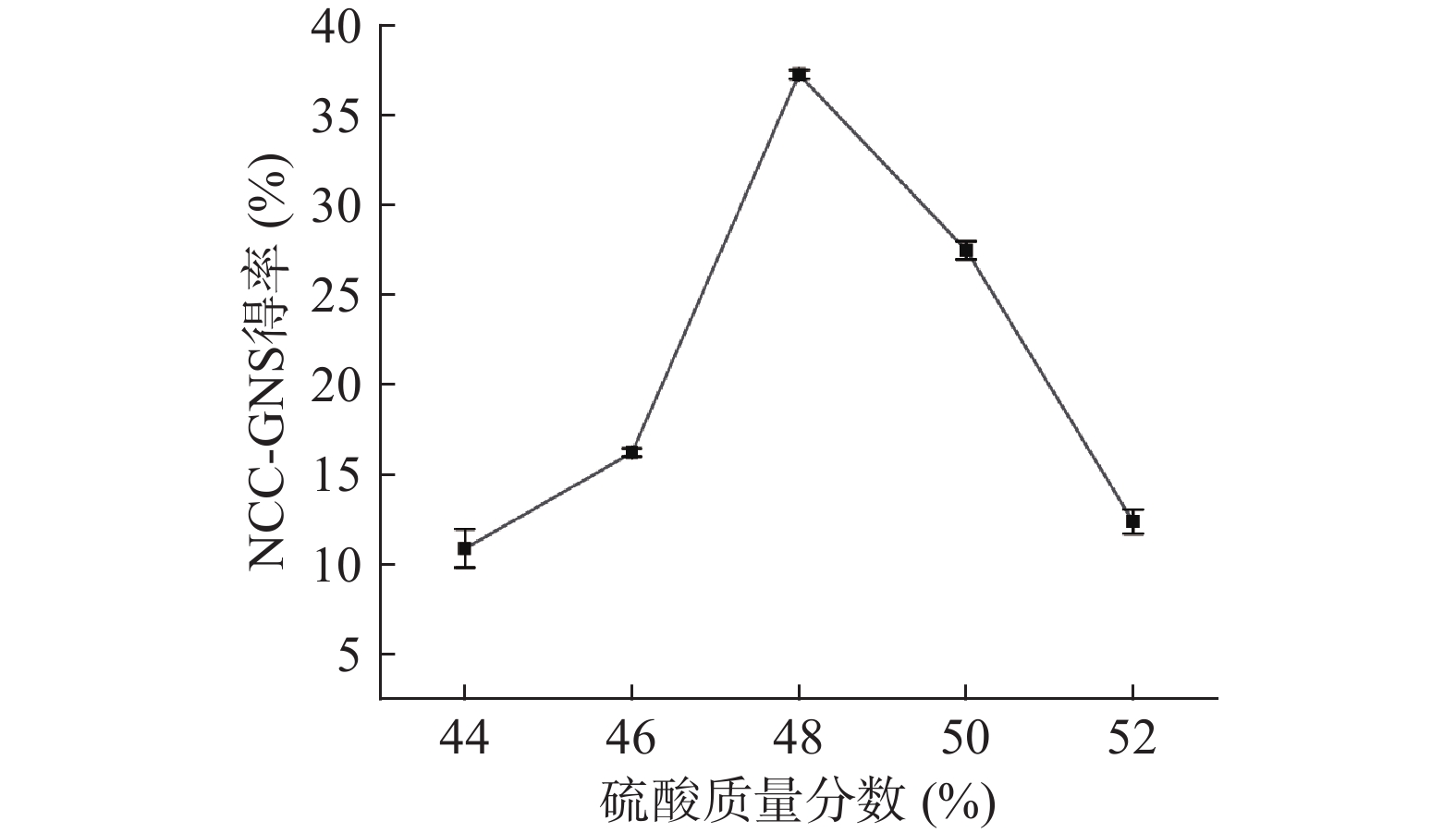| [1] |
Costa L A, Fonseca A F, Pereira F V, et al. Extraction and characterization of cellulose nanocrystals from corn stover[J]. Cellulose Chemistry Technology,2015,49(2):127−133.
|
| [2] |
Rosa M F, Medeiros E S, Maimonge J A, et al. Cellulose nanowhiskers from coconut husk fibers: Effect of preparation conditions on their thermal and morphological behavior[J]. Carbohydrate Polymers,2010,81(1):83−92. doi: 10.1016/j.carbpol.2010.01.059
|
| [3] |
Lou Zaixiang, Wang Hongxin, Li Jing, et al. Effect of simultaneous ultrasonic/microwave assisted extraction on the antioxidant and antibacterial activities of burdock leaves[J]. Journal of Medicinal Plants Research,2011,5(22):5370−5377.
|
| [4] |
Saha M, Eskicioglu C, Marin J. Microwave ultrasonic and chemo-mechanical pretreatments for enhancing methne potential of pulp mill wastewater treatment sludge[J]. Bioresource Technology,2011,102(17):7815−1826. doi: 10.1016/j.biortech.2011.06.053
|
| [5] |
Kolakovic R, Peltonen L, Laukkanen A, et al. Nanofibrillar cellulose films for controlled drug delivery[J]. European Journal of Pharmaceutics and Biopharmaceutics,2012,82(2):308−315. doi: 10.1016/j.ejpb.2012.06.011
|
| [6] |
Thennakoon M Udeni Gunathilake, Yern Chee Ching, Cheng Hock Chuah. Enhancement of curcumin bioavailability using nanocellulose reinforced chitosan hydrogel[J]. Polymers,2017,9(2):64.
|
| [7] |
|
| [8] |
张秀伶, 王稳航. 纳米纤维素研究及在食品工业中的应用前景[J]. 食品工业科技, 2016, 37(21): 377−382.
|
| [9] |
Wilson Pires Flauzino Neto, Hudson Alves Silvério, Noélio Oliveira Dantas, et al. Extraction and characterization of cellulose nanocrystals from agro-industrial residue-Soy hulls[J]. Industrial Crops and Products,2013,42:480−488. doi: 10.1016/j.indcrop.2012.06.041
|
| [10] |
Saleheen Bano, Yuvraj Singh Negi. Studies on cellulose nanocrystals isolated from groundnut shells[J]. Carbohydrate Polymers,2017,157:1041−1049. doi: 10.1016/j.carbpol.2016.10.069
|
| [11] |
Josh Marett, Alex Aning E, Johan Foster. The isolation of cellulose nanocrystals from pistachio shells via acid hydrolysis[J]. Industrial Crops & Products,2017,109:869−874.
|
| [12] |
刘潇, 董海洲, 侯汉学. 花生壳纳米纤维素的制备及其对淀粉膜性能的影响[J]. 中国粮油学报,2015,30(1):112−116.
|
| [13] |
|
| [14] |
宋孝周, 吴清林, 傅峰, 等. 农作物与其剩余物制备纳米纤维素研究进展[J]. 农业机械学报,2011,42(11):106−112.
|
| [15] |
Yang Ni, Li Jinwei, Fan Liuping. Production of nanocellulose with different length from ginkgo seed shells and applications for oil in water Pickering emulsions[J]. International Journal of Biological Macromolecules,2020,149:617−626. doi: 10.1016/j.ijbiomac.2020.01.263
|
| [16] |
Mehdi Jonoobi, Reza Oladi, Yalda Davoudpour, et al. Different preparation methods and properties of nanostructured cellulose from various natural resources and residues: A review[J]. Cellulose,2015,22(2):935−969. doi: 10.1007/s10570-015-0551-0
|
| [17] |
Yang Ni, Fan Liuping, Yong Sun. Interfacial properties of cellulose nanoparticles with different lengths from ginkgo seed shells[J]. Food Hydrocolloids,2020,109:106−121.
|
| [18] |
|
| [19] |
Alfred D French, Michael Santiago Cintrón. Cellulose polymorphy, crystallite size, and the Segal Crystallinity Index[J]. Cellulose,2013,20(1):583−588. doi: 10.1007/s10570-012-9833-y
|
| [20] |
Chen Wenshuai, Yu Haipeng, Liu Yixing, et al. Individualization of cellulose nanofibers from wood using high-intensity ultrasonication combined with chemical pretreatments[J]. Carbohydrate Polymers,2010,83(4):1804−1811.
|
| [21] |
Liu Haiyun, Liu Dagang, Yao Fei, et al. Fabrication and properties of transparent polymethy/methacrylate/cellulose nanocrystals composites[J]. Bioresource Technology,2010,101(14):5685−5692. doi: 10.1016/j.biortech.2010.02.045
|
| [22] |
Roni Marcos Dos Santos, Wilson Pires Flauzino Neto, Hudson Alves Silvério, et al. Cellulose nanocrystals from pineapple leaf, a new approach for the reuse of this agro-waste[J]. Industrial Crops and Products,2013,50:707−714. doi: 10.1016/j.indcrop.2013.08.049
|
| [23] |
Hanieh Kargarzadeh, Ishak Ahmad, Ibrahim Abdullah, et al. Effects of hydrolysis conditions on the morphology, crystallinity, and thermal stability of cellulose nanocrystals extracted from kenaf bast fibers[J]. Cellulose,2012,19(3):855−866. doi: 10.1007/s10570-012-9684-6
|
| [24] |
|
| [25] |
Ping Lu, You-Lo Hsieh. Cellulose isolation and core-shell nanostructures of cellulose nanocrystals from chardonnay grape skins[J]. Carbohydrate Polymers,2012,87(4):2546−2553. doi: 10.1016/j.carbpol.2011.11.023
|
| [26] |
Ping Lu, You-Lo Hsieh. Preparation and properties of cellulose nanocrystals: Rods, spheres, and network[J]. Carbohydrate Polymers,2010,82(2):329−336. doi: 10.1016/j.carbpol.2010.04.073
|
| [27] |
Araki J, Wada M, Kuga S, et al. Flow properties of microcrystalline cellulose suspension prepared by acid treatment of native cellulose[J]. Colloids and Surfaces A: Physicochemical and Engineering Aspects,1998,142(1):75−82.
|
| [28] |
Eliangela Morais Teixeira, Ana Carolina Corrêa, Alexandra Manzoli, et al. Cellulose nanofibers from white and naturally colored cotton fibers[J]. Cellulose,2010,17(3):595−606. doi: 10.1007/s10570-010-9403-0
|
| [29] |
George Johnsy, Ramana K V, Bawa A S, et al. Bacterial cellulose nanocrystals exhibiting high thermal stability and their polymer nanocomposites[J]. International Journal of Biological Macromolecules,2011,48(1):50−57. doi: 10.1016/j.ijbiomac.2010.09.013
|
| [30] |
Agustin M B, Nakatsubo F, Yano H. The thermal stability of nanocellulose and its acetates with different degree of polymerization[J]. Cellulose,2016,23(1):451−464. doi: 10.1007/s10570-015-0813-x
|











 DownLoad:
DownLoad: